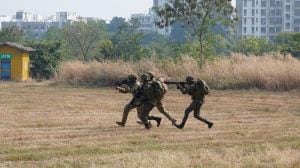Behind the scene, behind the deal
The MMA has given us its perspective on a proposed deal in the offing with the Pakistan government. But the government is not denying or con...

The MMA has given us its perspective on a proposed deal in the offing with the Pakistan government. But the government is not denying or confirming anything.
The prime minister, Zafarullah Jamali, has, however, offered to hold talks with the PPP’s Amin Fahim and PMLN’s Javed Hashmi in an effort to bring the two oppositionists into the equation as well.
This would suggest that Jamali wants to manufacture a broad consensus with the MMA and the ARD so that the final solution has the signature of all the political parties of Pakistan. So far so good. But where will it all end?
The MMA and the government have clearly agreed on some major points. (1) A constitutional amendment bill (15th amendment?) will be floated in parliament (like the 8th constitutional amendment bill between General Zia ul Haq and the Junejo-led parliament in 1985) to incorporate the elements of a ‘‘deal’’ on power sharing between 2/3rds of the elected parliament and the ‘‘un-elected’’ president.
By so doing, the government will concede that the Legal Framework Order (LFO) is not part of the constitution. This would be a victory for the opposition because this is what it has unanimously long claimed. (2) This amendment will indemnify and legitimise most, but not all, of the acts of General Pervez Musharraf’s regime since he seized power in October 1999, including the rules and regulations under which the general elections of 2002 were held.
(3) Among the sections of the LFO that will not be legitimised in the new constitutional amendment will be sections that deal with: the National Security Council; the presidential referendum; the president’s power to sack the cabinet, government and parliament without any repercussions on his own tenure; the three year extension in tenure given to senior judges, etc. (4) General Musharraf would seek election as president of Pakistan for five years via the various assemblies as laid down under the original constitution and his presidential status under the referendum would be de-legitimised. (General Zia did not have to seek election under the 8th amendment which accepted his presidential status as a ‘‘given’’ factor.)
(5) Under the new amendment the duly elected president (General Musharraf) would be entitled to dismiss the government and the parliament but the dismissal would be subject to the approval of the Supreme Court of Pakistan. If the SC does not uphold the decision, the president (General Musharraf) will have to quit.
Qazi Hussain Ahmad and Maulana Fazlur Rahman would also like us to believe that General Musharraf has agreed to the following proposals to be incorporated into the amendment: (a) He will agree now to shedding his uniform in October 2004. (b) He will stand for election as a civilian president after October 2004 and remain president for five years hence, ie from October 2004 to October 2009. But this is still doubtful.
If General Musharraf has accepted this solution, it would be another major victory for the opposition. In the event, however, and more significantly, it would also make nonsense of all the reasons that General Musharraf has given to justify why he cannot today give a date for taking off his uniform later.
It would therefore seem that there may still remain one mighty point of contention between the negotiators: the announcement of the date on which General Musharraf will take off his uniform.
Is it possible that a subtle variation on the theme might lead to the final solution? For example, General Musharraf might only be agreeable to accepting a date in October 2004 for the announcement of a date in 2005 or 2006 (before the next general elections in 2007) on which to shed his uniform.
This would give him greater political leverage in the next year or so than that accorded by the MMA’s proposal. In the meantime, he can seek election as president via the parliamentary route as proposed by the MMA.
A simpler version of this would be for General Musharraf to become an elected president immediately following a constitutional amendment along the above lines in which he is obliged to take off his uniform before a cut-off date a year or two hence.
In other words, instead of remaining an army chief and an un-elected president until 2004 as proposed by the MMA, he could become an elected president right away and remain army chief also for a year or two hence.
The other unresolved issue pertains to the PPP and PMLN. Will they go along with any of these proposals? We doubt it. General Musharraf has time and again heaped scorn and derision on the leaders of these two mainstream parties that among them received a majority of the vote in the last elections. He has refused to offer them any respite.
If he wants their thumb imprint on any constitutional amendment, he will have to go the extra mile and offer them a grand truth and reconciliation package that promises to rehabilitate them. And we don’t think he is big enough to do that right now.
But without them on board, anything that he and the MMA do separately or together will not be institutionalised in the political structure of Pakistan. And there lies the rub. (Courtesy: The Friday Times)
Photos





- 01
- 02
- 03
- 04
- 05


























